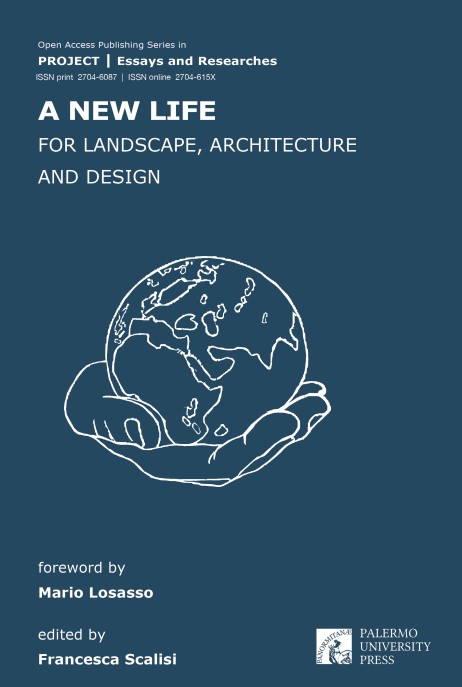
Title
IN-UP_Inhabiting the upcycling. Regenerative strategies for inhabiting the process
DOI
doi.org/ 10.19229/978-88-5509-291-3/642021
Keywords
regenerative processes, ERP neighbourhoods, systemic approach, circular economy, habitable building site
Abstract
The massive expansion of the suburbs in Italy between the 1950s and 1980s, characterised by the construction of subsidised public housing estates, has necessarily given way since the 1990s to physical and social redevelopment of large peripheral complexes. Starting from the project of technological, typological and energetic-environmental recovery of architectural artefacts and, more specifically, of public residential buildings, the contribution investigates the theme of regeneration by presenting the results of a project experience developed on the occasion of the RELIVE2020 design competition-workshop. The project proposal, through a systemic approach capable of providing a decisive contribution to regenerative processes, prefigures a replicable model of a resilient, inclusive and low environmental impact city.
Section
Architecture | Essays & Viewpoint
pp. 68-83
Author(s)
Ivana Coletta, Eduardo Bassolino
Author(s) Biography
Ivana Coletta, Architect, is a PhD Candidate at the Department of Architecture of the ‘Federico II’ University of Naples (Italy). She carries out research activities in the field of environmental design with particular reference to strategies and design actions for climate adaptation. Mob. +39 331/70.36.522 | E-mail: ivana.coletta@unina.it
Eduardo Bassolino, Architect and PhD, is a Researcher at the Department of Architecture, ‘Federico II’ University of Naples (Italy). He carries out research activities mainly in the field of climate adaptive design, environmental design and the use of IT Tools in architecture and urban design. Mob. +39 348/33.44.556 | E-mail: eduardo.bassolino@unina.it
References
Bellini, O. E. and Arcieri, M. (2020), “Il megaformalismo dell’abitare – Genealogia e prerogative di un potenziale morfo-tecnotipo | Megaformalism of living – Genealogy and prerogatives of a potential morpho-technotype”, in Agathón | International Journal of Architecture, Art and Design, vol. 7, pp. 102-113. [Online] Available at: doi.org/10.19229/2464-9309/7112020 [Accessed 24 February 2021].
Campioli, A., Dalla Valle, A., Ganassali, S. and Giorgi, S. (2018), “Progettare il ciclo di vita della materia – Nuove tendenze in prospettiva ambientale | Designing the life cycle of materials – New trends in environmental perspective”, in Techne | Journal of Technology for Architecture and Environment, vol. 16, pp. 86-95. [Online] Available at: doi.org/10.13128/Techne-23016 [Accessed 24 February 2021].
Cangelli, E. (2015), “Declinare la Rigenerazione – Approcci culturali e strategie applicate per la rinascita delle città | An up-close look at Urban Regeneration – Cultural approaches and applied strategies for the rebirth of cities”, in Techne | Journal of Technology for Architecture and Environment, vol. 10, pp. 59-66. [Online] Available at: doi.org/10.13128/Techne-17501[Accessed 24 February 2021].
Di Biagi, P. (2006), “La periferia pubblica – Da problema a risorsa per la città contemporanea”, in Belli A. (ed.), Oltre la Città – Pensare la periferia, Cronopio, Napoli, pp. 95-101.
Di Biagi, P. (ed.) (2001), La grande ricostruzione – Il piano Ina-Casa e l’Italia degli anni ’50, Donzelli Editore, Roma.
Gangemi, V. (ed.) (1988), Architettura e tecnologia appropriata, FrancoAngeli, Milano.
Gioffrè, V. (2018), Latent landscape – Interpretazioni, strategie, visioni, per la metropoli contemporanea, LetteraVentidue Edizioni, Siracusa.
Losasso, M., Leone, M. and Tersigni, E. (2020), “Approcci di computational design per la rigenerazione resiliente dello spazio pubblico | Computational design based approaches for public space resilient regeneration”, in Techne | Journal of Technology for Architecture and Environment, vol. 19, pp. 232-241. [Online] doi.org/10.13128/techne-7815 [Accessed 24 February 2021].
Nardi, G. (2001), Tecnologie dell’architettura – Teorie e storia, CLUP, Milano.
Perriccioli, M. (1995), “Assemblaggio”, in Vitale, A., Ascione, P., Falotico, A., Perriccioli, M. and Pone, S. (eds), Argomenti per il costruire contemporaneo, FrancoAngeli, Milano, pp. 33-56.
Sinopoli, N. and Tatano, V. (2002), Sulle tracce dell’innovazione tra tecniche e architettura, FrancoAngeli, Milano.
Tucci, F. (2020), “Tecnologia e generazione di habitat innovativi”, in Perriccioli, M., Rigillo, M., Russo Ermolli, S. and Tucci, F. (eds), Design in the Digital Age – Technology, Nature, Culture, Maggioli, Santarcangelo di Romagna (RN), pp. 323-325.
Valente, R. (2004), “Le materie seconde nella costruzione del paesaggio – Riferimenti per il progetto”, in Gangemi, V. (ed.), Riciclare in architettura – Scenari innovativi della cultura del progetto, CLEAN, Napoli, pp. 295-296.
Vitale, A. (1995), “Reversibilità”, in Vitale, A., Ascione, P., Falotico, A., Perriccioli, M. and Pone, S. (eds), Argomenti per il costruire contemporaneo, FrancoAngeli, Milano, pp. 103-118.
Zucchi, C. (2006), “La scala, la rete, il cespuglio – Percorsi concettuali del progetto contemporaneo”, in Di Battista, V., Giallocosta, G. and Minati, G. (eds), Architettura e approccio sistemico, Polimetrica, Monza, pp. 71-82.
